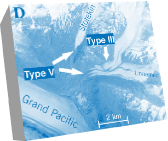

Theme 1: Environmental and glacial controls on ice flow dynamics and glacier surging
My PhD research (Jiskoot, 1999) was successful in identifying which glacio-morphometric, climatic, geological and topographical factors could control glacier surging (an internally triggered oscillatory flow instability in which abrupt increases in flow velocity are accompanied by a downglacier transport of ice and often a marked frontal advance). These controls were subsequently used to verify proposed surge mechanisms (Jiskoot et al., 2000; 2001; 2003; Murray et al., 2000; 2002; 2003). Since 2003, this research theme has been expanded with a focus on the interactions between glaciers and their tributaries, in order to understand the processes related to outflow restrictions in glacier systems. Presently, the main foci of this theme are to (i) analyse the effect of the presence and nature of tributaries on the flow regime of trunks, (ii) analyse the retreat and depletion rates of glaciers in conjunction with the disintegration of these glacier systems and (iii) to define measures, using morphometric and scaling techniques, for flow complexity based on the presence and nature of tributaries (e.g. Kargel et al., 2005). A major result of my research contributions over the past years is that new field and remote sensing-based observations and glacier data analysis led to the development of new insight into surge mechanisms (e.g. Jiskoot et al., 2000; 2001; 2003; Luckman et al., 2003; Murray et al., 2000; 2002; 2003; Jiskoot & Juhlin, 2009), as well as dynamic interactions in glacier systems (Kargel et al., 2005).
Specific contributions include
- Development of multivariate statistical techniques (Logit), which are novel to glaciology, to analyse a set of glacial, mass balance related, geological, and thermal attributes of glacier populations on the prevalence of surging in Svalbard, East Greenland and the Yukon Territory (Jiskoot et al. 2000; 2003).
- Extensive aerial photograph analyses of surging glaciers in Svalbard (Jiskoot et al., 2000) and East Greenland (Jiskoot et al., 2001; 2002; 2003; Luckman et al., 2003) have led to standardised identification of morphological evidence for surging.
- I developed predictive tools for glacier surging on the basis of glacial and environmental characteristics, which were used for the re-assessment of surging in Svalbard (Jiskoot et al., 2000) and E Greenland (Jiskoot et al., 2003).
- Multi-model photogrammetric analysis of the surge history and 1993-94 surge behaviour of Sortebræ, E Greenland, providing the first observational data on a surge in this region and subsequent new insights into surge behaviour (Jiskoot et al., 2001; Murray et al., 2002; 2003).
- Synthetic Aperture Radar (SAR) interferometric analysis of the spatial and temporal development of velocity during a glacier surge was performed as part of an ARCICE project (UK NERC grant) and led to the development of a new surge theory (Murray et al., 2003).
- Improved and novel techniques of testing and analysing large complex glacier datasets, with the capacity to test factors postulated to control ice flow instabilities glacier surging mechanisms in numerical and analytical models of ice sheets (Jiskoot, 1999; Jiskoot et al., 2000).
- Research on the characterisation of the Greenland ice sheet margins led to the identification of discrepancies between ice sheet model outputs and observations of margin topography and calving (Jiskoot & Marshall, 2002; 2003). This research involves numerical modelling and is still in progress.
- Discovery and/or initial analysis of a number of surging glaciers in Svalbard and Greenland (Jiskoot et al., 2001; Murray et al., 2003; Jiskoot & Juhlin, 2009).
